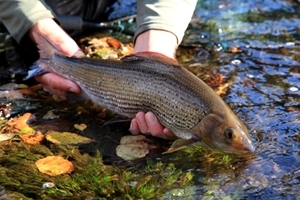European grayling
The lady of the stream: A fish as elegant in biology as it is in folklore
 The start of this month has seen the combines rolling across the fields in both the Allenford and Martin Down Farmer Clusters, which I have the pleasure of working with, which is a much earlier start to harvest than last year. This lovely weather has meant that summer fieldwork for me has been pretty plain sailing so far, with long, warm still days down here in the south – fingers crossed it continues.
The start of this month has seen the combines rolling across the fields in both the Allenford and Martin Down Farmer Clusters, which I have the pleasure of working with, which is a much earlier start to harvest than last year. This lovely weather has meant that summer fieldwork for me has been pretty plain sailing so far, with long, warm still days down here in the south – fingers crossed it continues.
It also has meant that I have been able to get out on the weekend and make the most of countryside around where I live, and as I stood on the bridge over our little chalk stream that runs through the village, I watched a grayling (Thymallus thymallus), my favourite fish species, hang in the flow below me, which gave me the inspiration for this Species of the Month.
I have always enjoyed fishing and was taught to flyfish many years ago by an old friend from Sparsholt College, but sadly, as with a lot of things, I just haven’t had the time recently. But even just seeing grayling gives me a lot of joy, as I walk the bank or stand by the river here in Hampshire.
Identification
The grayling is a distinctive cold water fish belonging in the salmonid family, subfamily Thymallinae. There is only one genus, but a number of species – six to be precise – which are distributed across parts of the Northern hemisphere (notably absent from Ireland).
Our grayling have long streamline, silvery, slender bodies, with large scales and a pale belly, with a recognisably huge sail-like dorsal fin, which is only prominent once grayling have reached a body length of 25mm. Both the male and female have dorsal fins, which are coloured and have four to five rows of red and black spots on an iridescent background, but the males’ fin is larger, which permits easy identification of the sexes. The male dorsal fin becomes very brightly coloured in the spring breeding season, and is used in courtship and defensive/offensive displays. An adult grayling is typically 30cm in length, but specimens can grow up to 60cm.
The head is small with large eyes, an underslung mouth adapted for bottom feeding on aquatic insects.
Its streamlined build and huge, brightly coloured, shimmering dorsal fin that dances in the current gives the grayling the lovely nickname ‘the Lady of the Stream’.
Habitat and distribution
European grayling are found in the UK and central and northern Europe. Grayling colonised British rivers when Britain was still connected to continental Europe at the end of the Pleistocene and early Holocene, by the North Sea land bridge, according to the Grayling Research Trust. English river systems thought to host native populations of grayling include the Yorkshire Ouse, Trent, Hampshire Avon, Severn, Wye, Thames and Ribble. The Welsh Dee is also thought to host native grayling. Elsewhere, grayling have been introduced. There is no evidence to suggest there have been any introductions of grayling to UK rivers from overseas.
There are no native grayling in Scottish rivers – all populations have arisen from introductions, the earliest being in the Clyde in the mid-19th Century. However, grayling generally thrive in the colder, clean waters, and are found extensively in the Annan, Clyde, Tweed and Tay systems, and in some of the rivers around the Forth. There are no grayling either in Northern Ireland or the Republic of Ireland.
Preferred habitat
- Good water quality: Grayling thrive in cool, clean, well-oxygenated rivers and streams. They are more sensitive to pollution and rising temperatures than even trout or salmon.
- Flowing water with varied currents.
- Gravel beds for spawning (March-May).
- Deeper pools and riffles for feeding.
- Microhabitat use: They often shoal in open water at the tail of pools, contrasting with trout that prefer marginal cover.
Lifecycle of a grayling
Grayling spawn between March and May, with females laying their eggs in gravel beds. Eggs hatch in 3-4 weeks, depending on the temperature. The larvae grow rapidly in the first year, with males maturing between two and three years while females mature between three and five.
Folklore and cultural stories
- ‘Lady of the Stream’: This poetic nickname reflects both the grayling’s beauty and its graceful movement through water. Its shimmering dorsal fin has inspired admiration and myth.
- Persecution and redemption: Once wrongly vilified by anglers as a threat to salmon eggs, grayling were historically culled in some UK rivers. Over time, this perception shifted thanks to advocacy by groups like the Grayling Society, who highlighted their ecological value and sporting appeal.
- Scottish myths: Some tales suggest grayling were once believed to be shape-shifters or omens of river health, appearing only in the cleanest waters.
- Uniquely, grayling are said to smell faintly of thyme, a trait that has intrigued anglers for centuries.
Trout or grayling?
Once shouted jokingly by my now-husband as we walked back from the Bush Inn pub on the River Itchen one sunny Saturday afternoon many years ago as he caught sight in the river below – but if you clearly see one, it’s easy to identify by its beautiful dorsal fin. A little glimmer of hope that the water quality in that that river is better than most.
Megan Lock